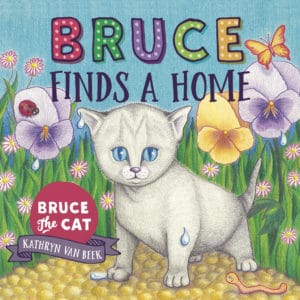The Cat That Got The Cream: How To Crowdfund A Book About Your Pet
Kathryn van Beek has been a contributor to The 13th Floor since our earliest days. Recently Kathryn, who is now based in Dunedin, has found fame, if not fortune, thanks to her cat, Bruce, who became an internet sensation when Katherine and her husband Tim rescued the kitten from the mean streets of Auckland. Now, Kathryn is ready to take the story of Bruce The Cat to the world…
Sometimes life takes you to strange places. In the past 18 months I’ve saved the life of a new-born kitten, developed a fan-base of 32,600 people for said kitten (Bruce the Cat), and written and illustrated a children’s book about him. Now I’m crowdfunding to publish the book.
 In this article I’ll share some crowdfunding tips, take you through publishing 101 and reveal how to make your pet famous. (I’ll also explain where The 13th Floor’s Marty Duda went wrong in his bid to make his cat a celebrity.)
In this article I’ll share some crowdfunding tips, take you through publishing 101 and reveal how to make your pet famous. (I’ll also explain where The 13th Floor’s Marty Duda went wrong in his bid to make his cat a celebrity.)
Crowdfunding in five easy steps
Easy steps? Ha. Crowdfunding is hard – only between thirty and forty per cent of crowdfunding projects actually meet their targets. If you’re thinking about running this particular marathon, here are five things that will help you get in shape.
- Develop an audience. Ninety per cent of pledges to my book have come from people I’ve sent to my project page – just ten per cent have come from the platform itself (I’m using Kickstarter). You can’t rely on people to magically discover your project – you need to grow your audience months in advance.
- Build your foundation. Do your research to figure out which platform to use, what your funding target will be and how you’ll structure your rewards. Hot tip: I listened to crowdfunding podcasts while I did household chores in the months leading up to my campaign!
- Create a profile. I read through and pledged to a lot of other crowdfunding campaigns so I could see what worked and what didn’t before I created my profile. A key component of your campaign is your video – take it seriously.
- Master Google and Facebook analytics. I wish I had invested more time in this before I launched. I have Google analytics for my Kickstarter page, and Kickstarter itself gives me limited analytics, but I haven’t connected Facebook to Google – meaning I can’t test whether or not my ads are working. Now I’m trying to learn on the fly, when I should have started experimenting months ago.
- Plan your marketing strategy. The crowdfunding campaign is a month-long hustle to get as many eyeballs on your page as possible. Prepare as much of this work beforehand as you can (eg writing and sending your media release, creating a media pack, reaching out to bloggers, drafting guest blog posts). Hot tip: I advertised on The Big Idea and found two amazing interns who have helped me out with graphic design and blogger outreach.
 I wrote a more in-depth article on crowdfunding here – and there are plenty of other resources online. (In the lead-up to my campaign I recorded every useful tip I came across and turned it into an action point to follow up on.)
I wrote a more in-depth article on crowdfunding here – and there are plenty of other resources online. (In the lead-up to my campaign I recorded every useful tip I came across and turned it into an action point to follow up on.)
Publish your book in three easy steps
- Write the book.
- Figure out how you will publish it. You’ve got a few options here:
- You could try pitching to traditional publishers.
- You could publish online. (I’m friends with a romance writer who does very well on Amazon.)
- You could offer your book for sale via a print on demand service such as Ingram Spark.
- You could self-publish, print the book and distribute it yourself. (Note that if you choose options b – d you will probably want to hire an editor and a designer in order to get the book looking as professional as possible.)
- You could do what I did and enter into a joint publishing venture with a publishing house.
- Fund it. Do you have $20K? If yes – easy. If no – have you considered crowdfunding?
So what is a joint publishing venture, and how does it work? I spoke to Sophia Egan-Reid, General Manager at Mary Egan Publishing (who I’m publishing through), to get her take.
 “We are an independent publisher. We do everything a trade publisher does, but we are paid for our services and the author retains all copyrights and profits. We produce books of the highest standard and can help with everything from editing, design and print to marketing and distribution. There is much more flexibility publishing this way, the author and illustrator get a lot more input than they would with a trade publisher,” Sophia says.
“We are an independent publisher. We do everything a trade publisher does, but we are paid for our services and the author retains all copyrights and profits. We produce books of the highest standard and can help with everything from editing, design and print to marketing and distribution. There is much more flexibility publishing this way, the author and illustrator get a lot more input than they would with a trade publisher,” Sophia says.
 “A successful book should follow the exact same steps a commercially published book does: assessment, editing, design, production and marketing. Being successful is all about thinking differently, working hard, pushing sales and appealing to your target market. And the secret ingredient: the harder you work, the more money you make.”
“A successful book should follow the exact same steps a commercially published book does: assessment, editing, design, production and marketing. Being successful is all about thinking differently, working hard, pushing sales and appealing to your target market. And the secret ingredient: the harder you work, the more money you make.”
Make your cat famous in five easy steps
Ok so now we’ve got through the serious stuff – how do you turn your pet into a celebrity?
- Have an angle. Does your cat look weird? Was it found under unusual circumstances? Is it disabled? If the answer to all these questions is no, train it to do something most other cats can’t (eg horse-riding).
- Keep your house and garden tidy. Nothing spoils a killer photo like a pile of dishes or a mound of weeds in the background.
- Post regularly. Post at least once a day but mix up the types of posts – photos, videos, competitions, news articles… Check in on your analytics to see what’s popular and let those insights help guide you.
- Treat your followers as you would like to be treated. Keep your cat’s social feed politics-free. Be friendly and engage with your followers. Ask them about their own pets and get them to share their own cat photos (they’ll love that!).
- Treat your cat as you would like to be treated. There’s nothing like the faint taint of animal abuse to ruin a good social post. We’ve dressed Bruce up a couple of times, but in fairness to Bruce (and the environment) we now avoid pet shop tat and Photoshop our seasonal messages instead. (As an added bonus, the Photoshopped posts have had better reach than the dress-up ones anyway.)
Case study: Where did Marty go wrong?
In 2014 Marty’s feline companion Cattrick got the big break pet owners dream of when she was featured in The New Zealand Herald after getting stuck in a crawl space and rescued by firefighters. Marty could have capitalised on this by creating a Cattrick Facebook page and writing a follow-up story for The 13th Floor. Instead Cattrick spent the rest of her days languishing in obscurity as Symonds Street’s most unpredictable cat. (Sadly Cattrick passed away in 2015.)
Find out more
Visit Kathryn’s crowdfunding campaign for Bruce Finds A Home
Visit Kathryn’s blog to read more about what she’s learnt on her crowdfunding journey
- Challengers – Dir: Luca Guadagnino (Film Review) - April 24, 2024
- Civil War – Dir: Alex Garland (Film Review) - April 9, 2024
- Pearl Jam – Dark Matter (Monkeywrench/Republic) Album Review - April 1, 2024
